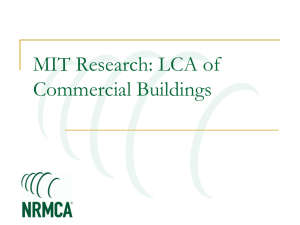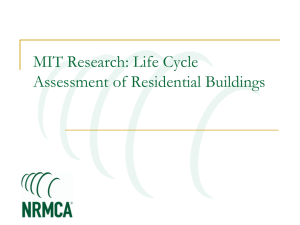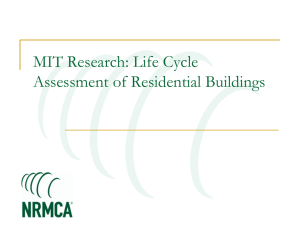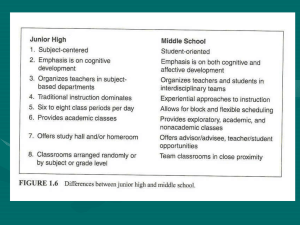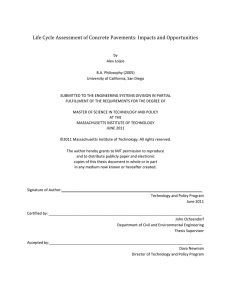MIT Concrete Sustainability Hub
advertisement
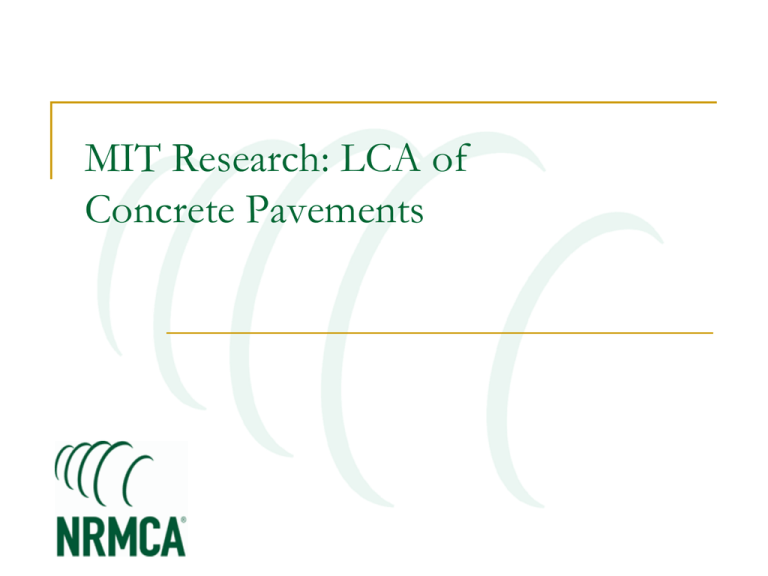
MIT Research: LCA of Concrete Pavements MIT Concrete Sustainability Hub $10 million investment over 5 years Funded equally by RMCREF & PCA NRMCA providing technical support and guidance NRMCA and state associations to play a critical role in the technology transfer Goals Identify areas in which concrete excels Identify opportunities for improvement Create solid technical basis for future industry development 3 Research Platforms Concrete Science Platform: Mission Scientific breakthroughs toward reducing CO2 footprint of cement and concrete Strength with less material Lower energy processing Chemical stability Building Technology Platform Mission: Life Cycle Assessment (LCA) of Concrete Buildings and Pavements to Identify Impacts and Opportunities Research Topics: Material Flow Analysis LCA of commercial buildings LCA of residential buildings LCA of pavements LCCA of building materials LCA of Concrete Pavements 2.6 million miles of public roadways 3 trillion vehicle miles Road transport contribute most GHG of any transport mode Construction and maintenance consumes energy and resources Methodology Standardized LCA methodology critical Increase consistency of LCA MIT proposes good practices for LCA Methodology Transparency of data Define scope Identify system boundaries Define functional unit Goal and Scope Assess environmental impact of concrete pavements For entire life cycle Quantify cumulative environmental impacts Ways to reduce GHG emissions Boundaries Functional Unit High volume road Moderate volume road Low volume road Functional Units Functional Unit Length of one kilometer (or mile) Impacts Global Warming Potential (GWP) of concrete pavements: Rural Local Roads = 600 tons CO2e/mi (340 Mg CO2e/km) Urban Interstates = 11,000 tons CO2e/mi (6,300 Mg CO2e/km) Note: CO2e = Carbon Dioxide Equivalents (used as an indicator of GWP) Impacts Greenhouse Gas Emissions (GHG) emissions from cement production are the largest contributor: Urban Interstates = 45% Rural Local Roads = 72% Note: CO2e = Carbon Dioxide Equivalents (used as an indicator of GWP) Impacts For 9 of 12 pavement designs Second largest contributor to GWP is fuel consumed from roughness Note: CO2e = Carbon Dioxide Equivalents (used as an indicator of GWP) Relative GWP Impact Reduction Increase Fly Ash GWP could be reduced by 15% for urban interstates to 36% for local roads by increasing the percentage of fly ash in concrete from 10% to 30%. Impact Reduction Increasing the albedo of concrete Reduces the urban heat island effect resulting in 43% reduction in GWP Opportunities for increasing albedo White aggregate White cement Pervious concrete Photocatalytic cement Two-lift paving (high albedo materials in top surface) Impact Reduction Carbonation Crushing and stockpiling concrete for one year sequesters 28% of initial CO2 released. EOL stockpiling EOL: embankments EOL: subbases Pervious concrete Impact Reduction Extra Rehabilitation An additional rehabilitation (grinding) will reduce pavement roughness Benefits LCA Reduces roughness to initial IRI (International Roughness Index) Uncarbonated concrete is exposed for the carbonation process to begin again Reduces GWP by 13% for urban interstates Increases GWP for rural local roads by 10% Impact Reduction Impact Reduction Impact Reduction: Pavement Vehicle Interaction LCA Boundary For High Volume Roadway Resource Extraction Processing Placement Embodied Emissions: 20% PVI ~ 70% Use Phase Recycling Operational Emissions: 80% Pavement Vehicle Interaction Mechanistic model for pavement deflection Asphalt pavement 1.6 times thicker than an equivalent concrete pavement to achieve the same fuel consumption. Impact Reduction: Pavement Vehicle Interaction 2500 GHG Emissions (Mg CO2e) PVI (Deflection) 2000 Production + M&R 50 yr GHG Emissions of Two Pavement Scenarios Relative to a “Flat” Pavement 1500 1000 500 0 Concrete Asphalt Concrete Asphalt More Information Full report available from MIT Concrete Sustainability Hub at web.mit.edu/cshub MIT Hub established by RMC Research & Education Foundations Portland Cement Association NRMCA providing technical support Transfer research into practice Visit www.nrmca.org
